2011 TOYOTA LAND CRUISER Engine temperature
[x] Cancel search: Engine temperaturePage 4 of 608

TABLE OF CONTENTSIndex
4
L/C200_U (OM60F74U)
3-5. Using the interior lightsInterior lights list ................. 379
• Interior lights .................... 380
• Personal lights ................. 381
3-6. Using the storage features List of storage features....... 382
• Glove box ......................... 383
• Console box ..................... 384
• Overhead console ............ 385
• Cup holders...................... 386
• Bottle holders ................... 387
• Card holders .................... 389
• Auxiliary box..................... 389
3-7. Other interior features Cool box ............................. 390
Sun visors .......................... 392
Vanity mirror ....................... 393
Clock .................................. 394
Outside temperature display .............................. 395
Ashtrays ............................. 396
Cigarette lighter .................. 398
Power outlets ..................... 399
Seat heaters ....................... 401
Armrest............................... 403
Floor mats .......................... 404
Luggage compartment features ............................ 406
Garage door opener ........... 408
Safety Connect................... 415 4-1. Maintenance and care
Cleaning and protecting the vehicle exterior ........... 424
Cleaning and protecting the vehicle interior ............ 427
4-2. Maintenance Maintenance requirements .................... 430
General maintenance ......... 432
Emission inspection and maintenance (I/M)
programs .......................... 435
4-3. Do-it-yourself maintenance Do-it-yourself service precautions ....................... 436
Hood ................................... 439
Engine compartment .......... 440
Tires.................................... 455
Tire inflation pressure ......... 464
Wheels................................ 468
Air conditioning filter ........... 470
Electronic key battery ......... 473
Checking and replacing fuses ................................. 476
Light bulbs .......................... 489
4Maintenance and care
Page 149 of 608
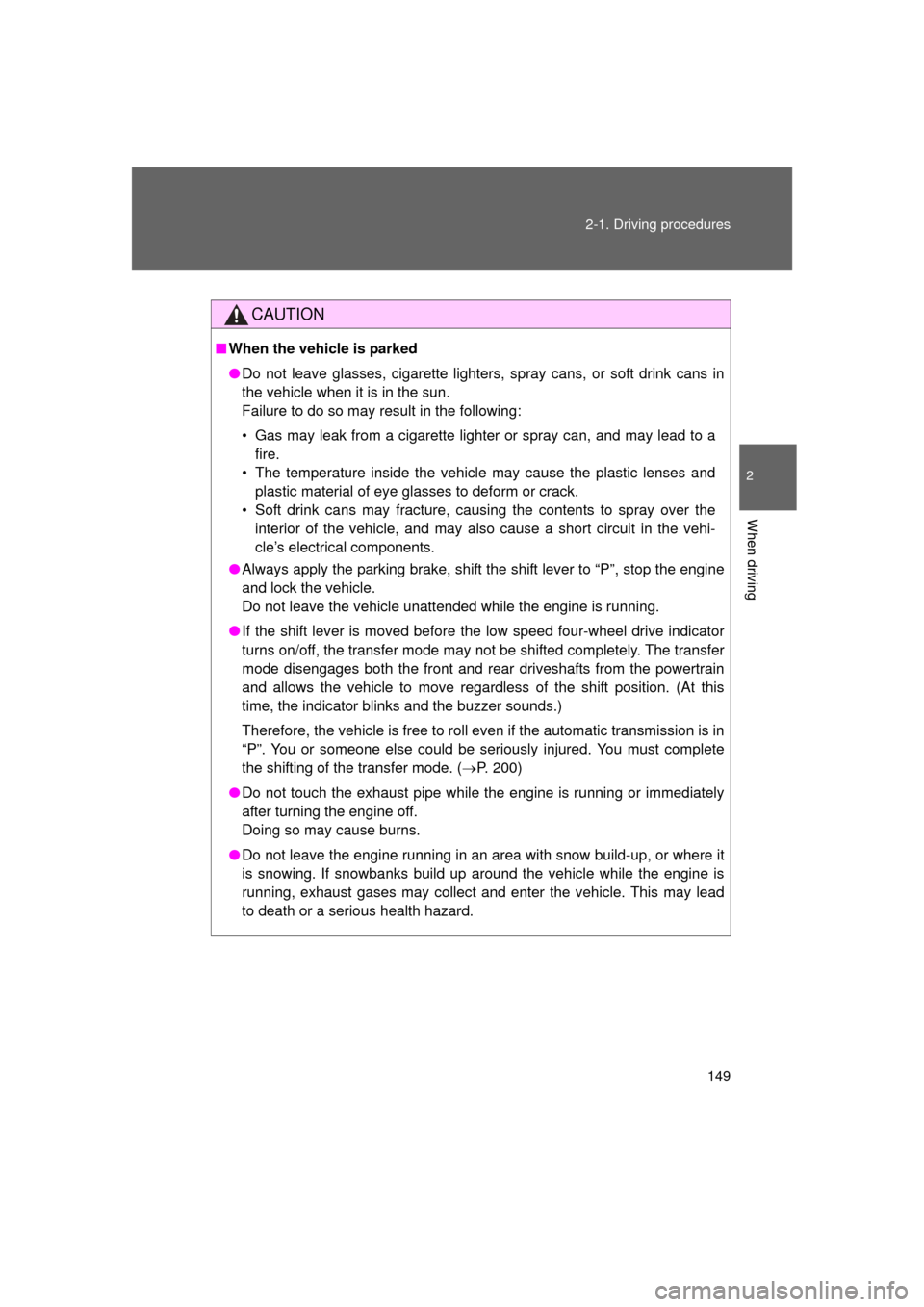
149
2-1. Driving procedures
2
When driving
L/C200_U (OM60F74U)
CAUTION
■
When the vehicle is parked
● Do not leave glasses, cigarette lighters, spray cans, or soft drink cans in
the vehicle when it is in the sun.
Failure to do so may result in the following:
• Gas may leak from a cigarette lighter or spray can, and may lead to a
fire.
• The temperature inside the vehicle may cause the plastic lenses and plastic material of eye glasses to deform or crack.
• Soft drink cans may fracture, causing the contents to spray over the interior of the vehicle, and may also cause a short circuit in the vehi-
cle’s electrical components.
● Always apply the parking brake, shift the shift lever to “P”, stop the engine
and lock the vehicle.
Do not leave the vehicle unattended while the engine is running.
● If the shift lever is moved before the low speed four-wheel drive indicator
turns on/off, the transfer mode may not be shifted completely. The transfer
mode disengages both the front and rear driveshafts from the powertrain
and allows the vehicle to move regardless of the shift position. (At this
time, the indicator blinks and the buzzer sounds.)
Therefore, the vehicle is free to roll even if the automatic transmission is in
“P”. You or someone else could be seriously injured. You must complete
the shifting of the transfer mode. ( P. 200)
● Do not touch the exhaust pipe while the engine is running or immediately
after turning the engine off.
Doing so may cause burns.
● Do not leave the engine running in an area with snow build-up, or where it
is snowing. If snowbanks build up around the vehicle while the engine is
running, exhaust gases may collect and enter the vehicle. This may lead
to death or a serious health hazard.
Page 166 of 608
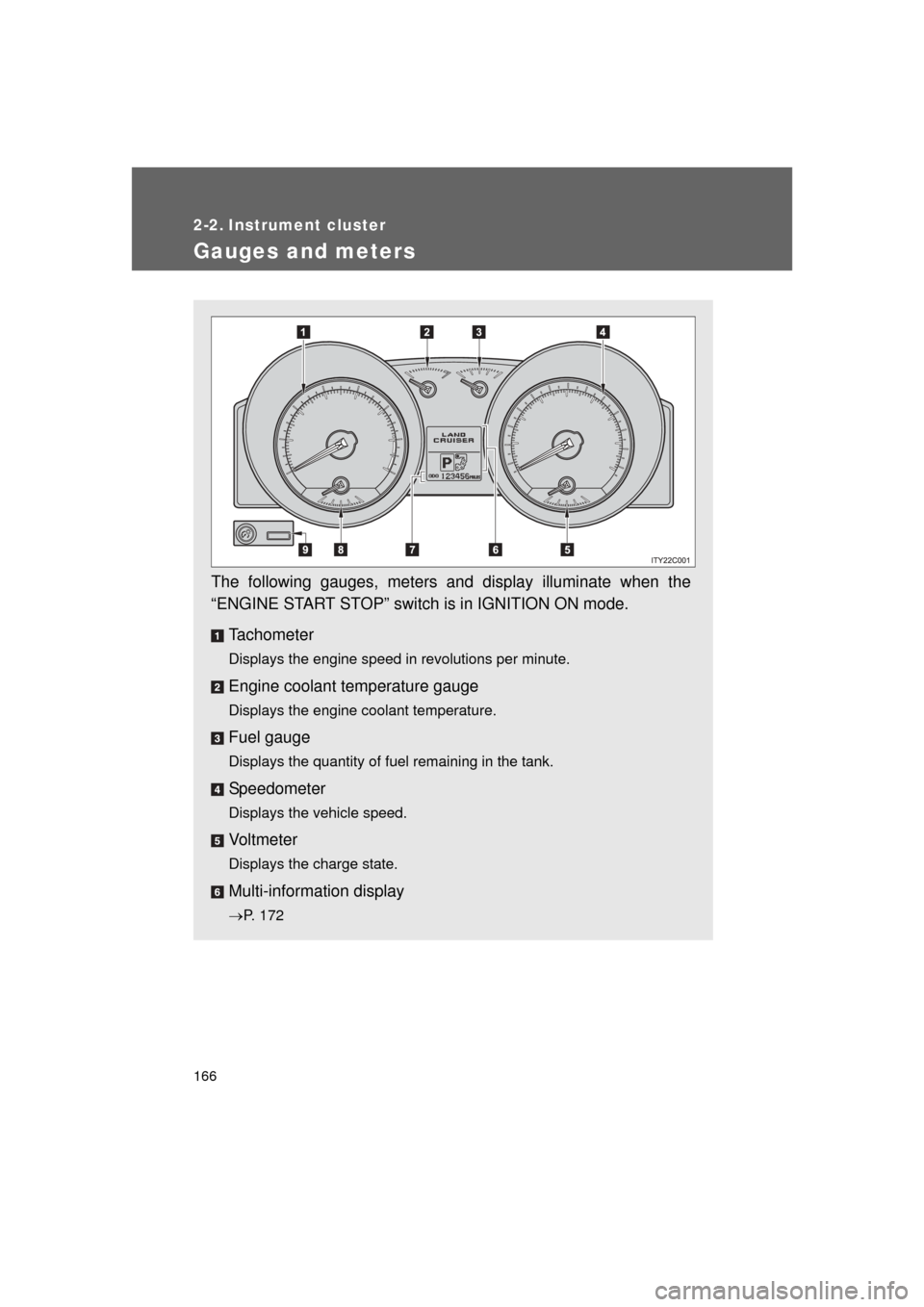
166
L/C200_U (OM60F74U)
2-2. Instrument cluster
Gauges and meters
The following gauges, meters and display illuminate when the
“ENGINE START STOP” switch is in IGNITION ON mode.Tachometer
Displays the engine speed in revolutions per minute.
Engine coolant temperature gauge
Displays the engine coolant temperature.
Fuel gauge
Displays the quantity of fuel remaining in the tank.
Speedometer
Displays the vehicle speed.
Vo l t m e t e r
Displays the charge state.
Multi-informat ion display
P. 172
Page 168 of 608
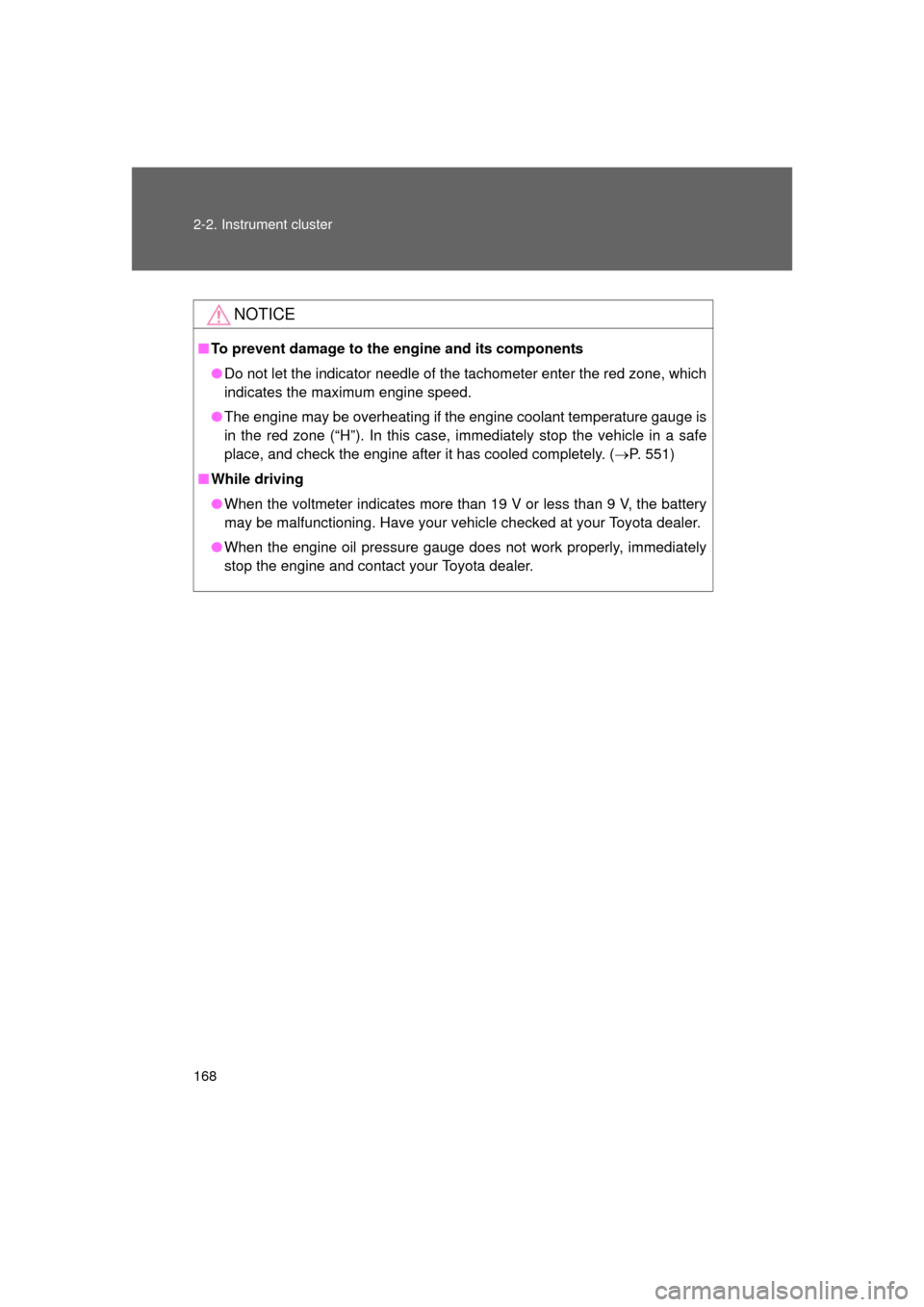
168 2-2. Instrument cluster
L/C200_U (OM60F74U)
NOTICE
■To prevent damage to the engine and its components
● Do not let the indicator needle of the tachometer enter the red zone, which
indicates the maximum engine speed.
● The engine may be overheating if the engine coolant temperature gauge is
in the red zone (“H”). In this case, immediately stop the vehicle in a safe
place, and check the engine after it has cooled completely. ( P. 551)
■ While driving
● When the voltmeter indicates more than 19 V or less than 9 V, the battery
may be malfunctioning. Have your vehicle checked at your Toyota dealer.
● When the engine oil pressure gauge does not work properly, immediately
stop the engine and contact your Toyota dealer.
Page 175 of 608
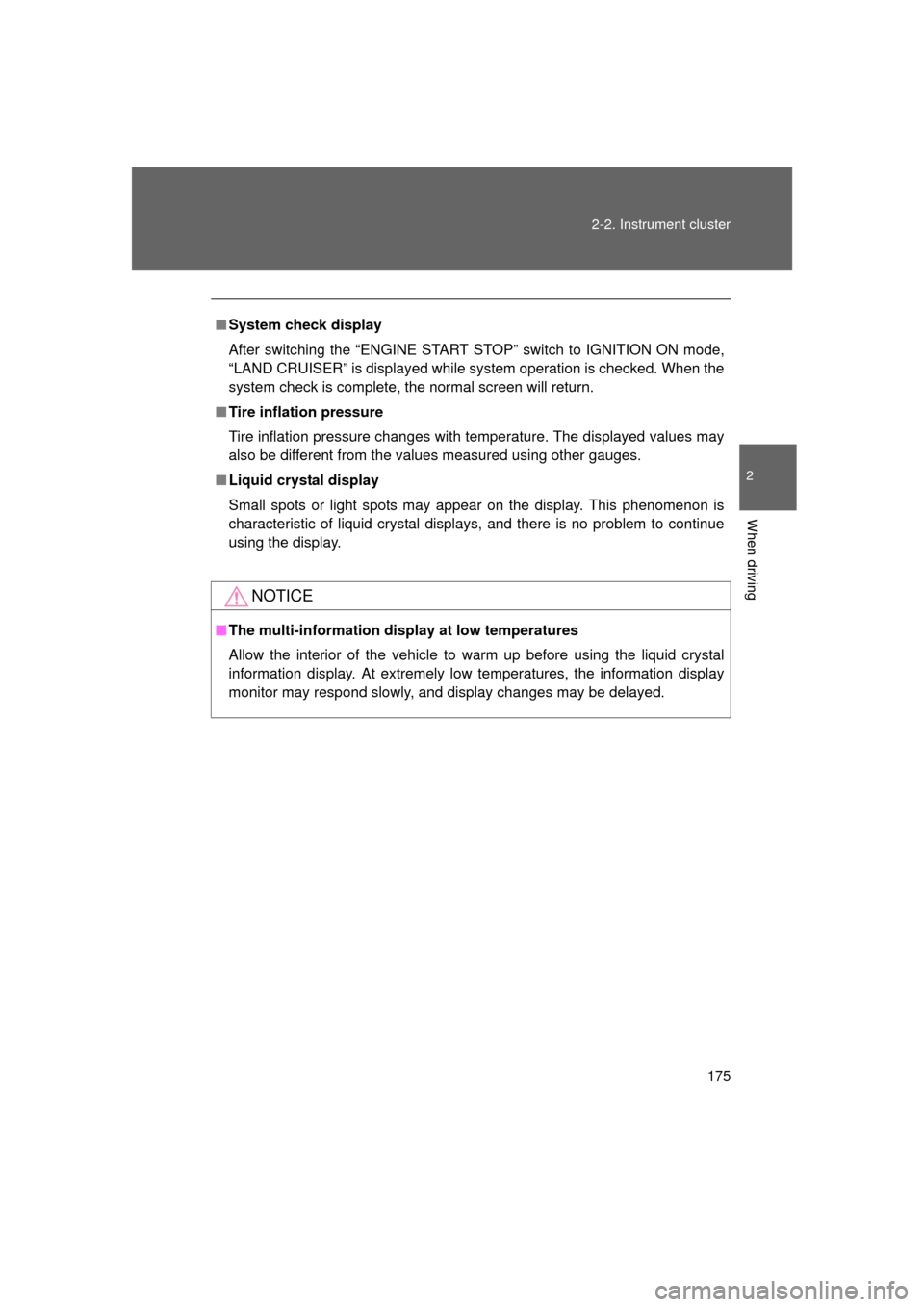
175
2-2. Instrument cluster
2
When driving
L/C200_U (OM60F74U)
■
System check display
After switching the “ENGINE START STOP” switch to IGNITION ON mode,
“LAND CRUISER” is displayed while system operation is checked. When the
system check is complete, the normal screen will return.
■ Tire inflation pressure
Tire inflation pressure changes with temperature. The displayed values may
also be different from the values measured using other gauges.
■ Liquid crystal display
Small spots or light spots may appear on the display. This phenomenon is
characteristic of liquid crystal displays, and there is no problem to continue
using the display.
NOTICE
■The multi-information disp lay at low temperatures
Allow the interior of the vehicle to warm up before using the liquid crystal
information display. At extremely low temperatures, the information display
monitor may respond slowly, and display changes may be delayed.
Page 183 of 608
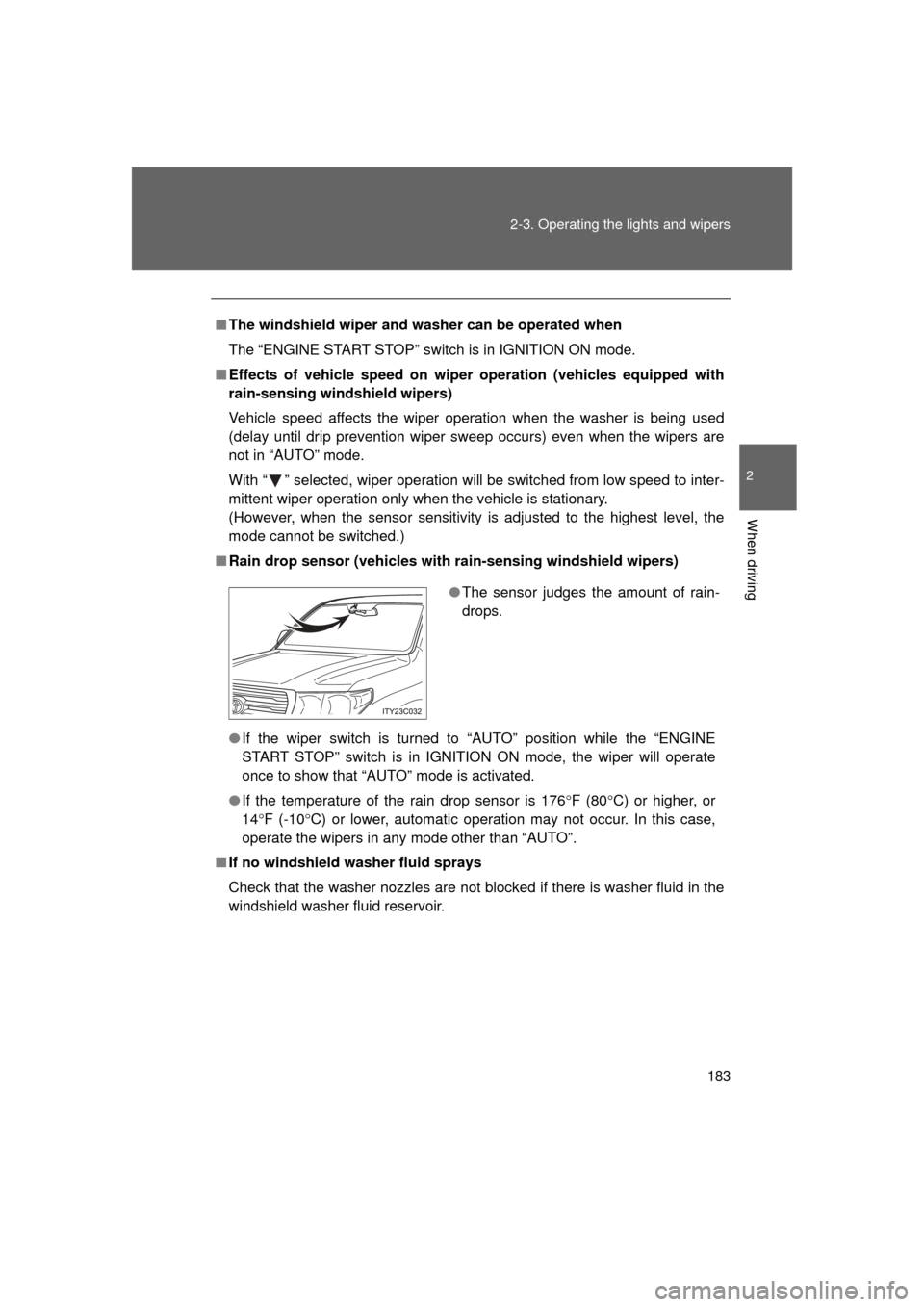
183
2-3. Operating the lights and wipers
2
When driving
L/C200_U (OM60F74U)
■
The windshield wiper and washer can be operated when
The “ENGINE START STOP” switch is in IGNITION ON mode.
■ Effects of vehicle speed on wiper operation (vehicles equipped with
rain-sensing windshield wipers)
Vehicle speed affects the wiper operation when the washer is being used
(delay until drip prevention wiper sweep occurs) even when the wipers are
not in “AUTO” mode.
With “ ” selected, wiper operation will be switched from low speed to inter-
mittent wiper operation only when the vehicle is stationary.
(However, when the sensor sensitivity is adjusted to the highest level, the
mode cannot be switched.)
■ Rain drop sensor (vehicles with rain-sensing windshield wipers)
● If the wiper switch is turned to “AUTO” position while the “ENGINE
START STOP” switch is in IGNITION ON mode, the wiper will operate
once to show that “AUTO” mode is activated.
● If the temperature of the rain drop sensor is 176 F (80 C) or higher, or
14 F (-10 C) or lower, automatic operation may not occur. In this case,
operate the wipers in any mode other than “AUTO”.
■ If no windshield washer fluid sprays
Check that the washer nozzles are not blocked if there is washer fluid in the
windshield washer fluid reservoir.
●The sensor judges the amount of rain-
drops.
Page 203 of 608
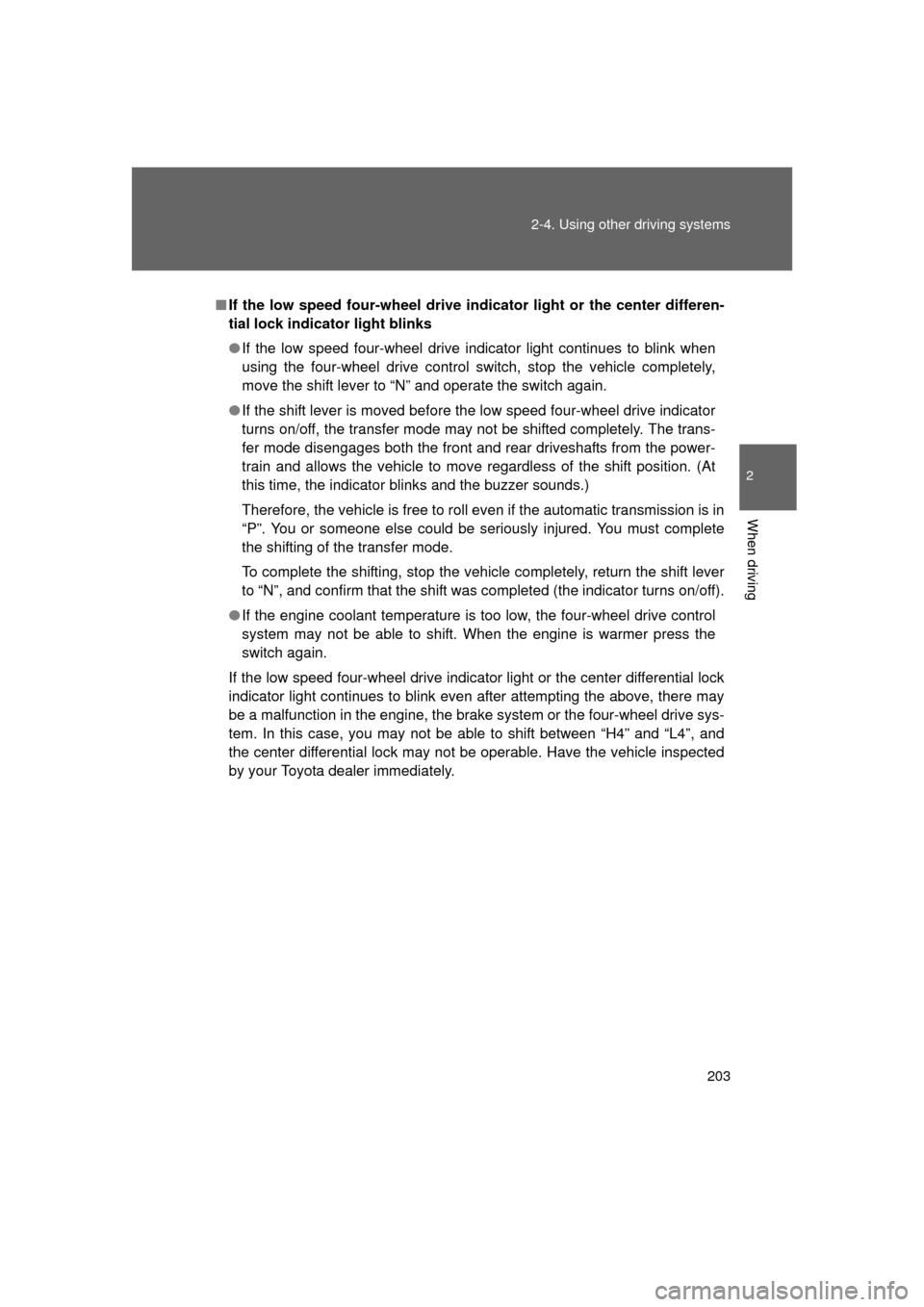
203
2-4. Using other
driving systems
2
When driving
L/C200_U (OM60F74U)
■If the low speed four-wheel drive in dicator light or the center differen-
tial lock indicator light blinks
● If the low speed four-wheel drive indicator light continues to blink when
using the four-wheel drive control switch, stop the vehicle completely,
move the shift lever to “N” and operate the switch again.
● If the shift lever is moved before the low speed four-wheel drive indicator
turns on/off, the transfer mode may not be shifted completely. The trans-
fer mode disengages both the front and rear driveshafts from the power-
train and allows the vehicle to move regardless of the shift position. (At
this time, the indicator blinks and the buzzer sounds.)
Therefore, the vehicle is free to roll even if the automatic transmission is in
“P”. You or someone else could be seriously injured. You must complete
the shifting of the transfer mode.
To complete the shifting, stop the vehicle completely, return the shift lever
to “N”, and confirm that the shift was completed (the indicator turns on/off).
● If the engine coolant temperature is too low, the four-wheel drive control
system may not be able to shift. When the engine is warmer press the
switch again.
If the low speed four-wheel drive indicator light or the center differential lock
indicator light continues to blink even after attempting the above, there may
be a malfunction in the engine, the brake system or the four-wheel drive sys-
tem. In this case, you may not be able to shift between “H4” and “L4”, and
the center differential lock may not be operable. Have the vehicle inspected
by your Toyota dealer immediately.
Page 207 of 608
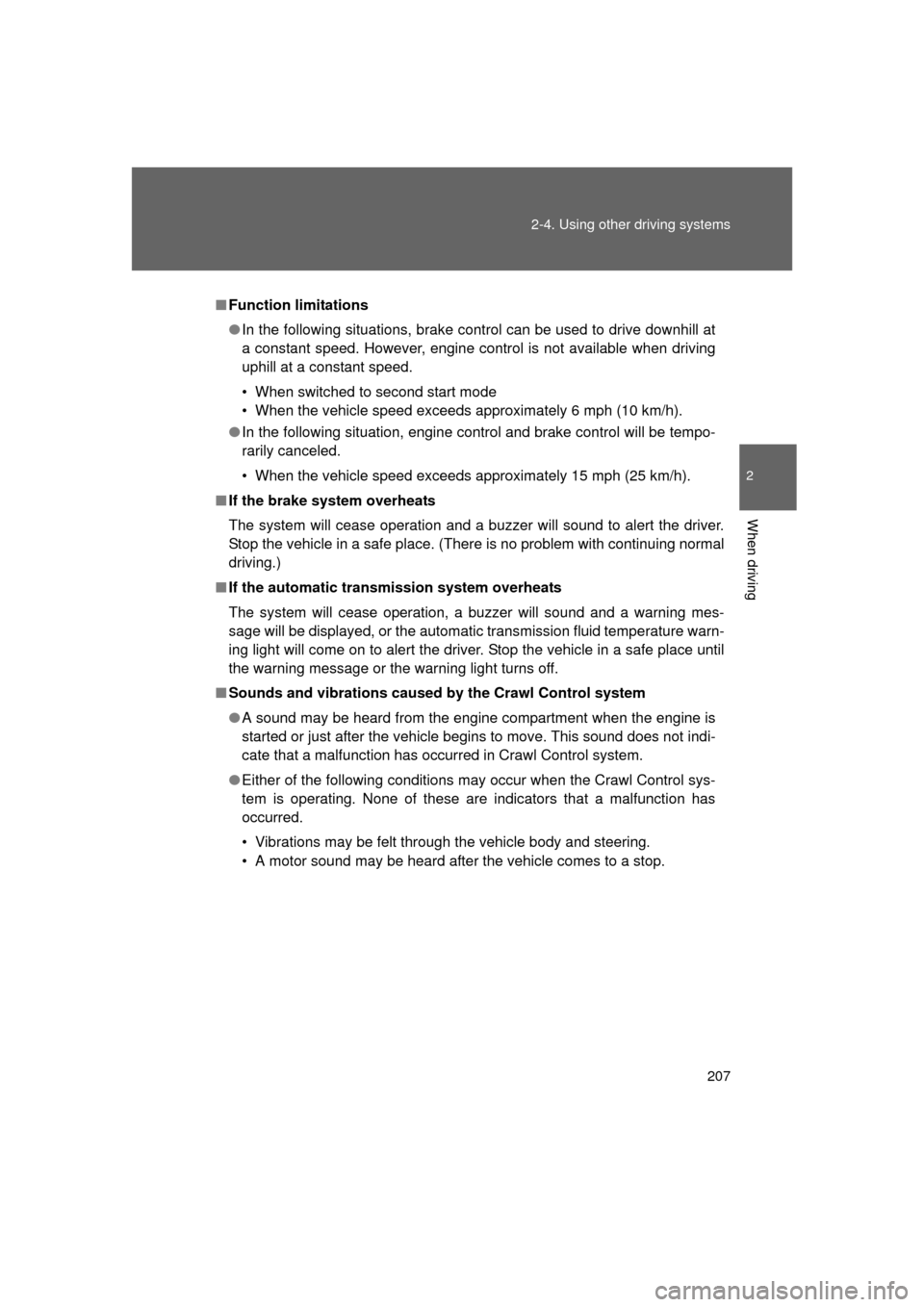
207
2-4. Using other
driving systems
2
When driving
L/C200_U (OM60F74U)
■Function limitations
● In the following situations, brake control can be used to drive downhill at
a constant speed. However, engine control is not available when driving
uphill at a constant speed.
• When switched to second start mode
• When the vehicle speed exceeds approximately 6 mph (10 km/h).
● In the following situation, engine control and brake control will be tempo-
rarily canceled.
• When the vehicle speed exceeds approximately 15 mph (25 km/h).
■ If the brake system overheats
The system will cease operation and a buzzer will sound to alert the driver.
Stop the vehicle in a safe place. (Ther e is no problem with continuing normal
driving.)
■ If the automatic transmission system overheats
The system will cease operation, a buzzer will sound and a warning mes-
sage will be displayed, or the automat ic transmission fluid temperature warn-
ing light will come on to alert the driver. Stop the vehicle in a safe place until
the warning message or the warning light turns off.
■ Sounds and vibrations caused by the Crawl Control system
● A sound may be heard from the engine compartment when the engine is
started or just after the vehicle begins to move. This sound does not indi-
cate that a malfunction has occurred in Crawl Control system.
● Either of the following conditions may occur when the Crawl Control sys-
tem is operating. None of these are indicators that a malfunction has
occurred.
• Vibrations may be felt through the vehicle body and steering.
• A motor sound may be heard after the vehicle comes to a stop.